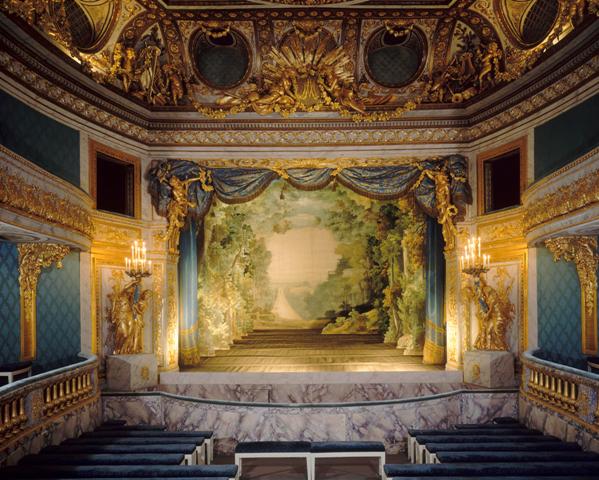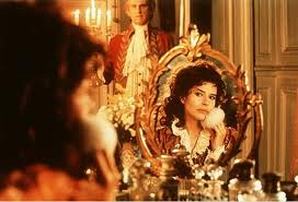Affair of the Necklace (2001) Dir: Charles Shyer
Above: director Charles Shyer with Hilary Swank
What's it all about?

Reconstruction of the 'Queen's Necklace'.
This beautifully photographed and elaborately costume movie has as its subject a famous scandal that involved Marie Antoinette and the royal court at Versailles during 1785-6, just before the outbreak of the French Revolution. This scandal - variously known as the Affair of the Queen's Diamonds or the Affair of the Queen's Necklace - would seem to have many features that would make the movie a success. It occurred in a glamorous setting, featured sexual and political intrigue and involved some fascinating and important people, including the Queen of France, a Cardinal-playboy, and scheming, devious courtiers. It was also an important factor in bolstering the French public's perception of the Queen and the Court as extravagant wastrels wallowing in a world of privilege, luxury and deceit. The movie featured a talented cast: Hilary Swank (recent Academy Award winner), Christopher Walken, Adrian Brody, Jonathan Pryce. Yet on release the movie proved unsuccessful with critics and public alike.
The Historical Background to the Affair of the Queen's Necklace
|
One of the reasons for the movie's failure was its inability to concisely explain what was in fact the complicated historical context of the affair. What actually happened requires some knowledge of the key personalities involved, an understanding of Versailles' ritual and intrigues, and a grasp of the political and social background of a turbulent decade.
The scandalous affair around which the movie is set involves the scheming of Jeanne, Comtesse de la Motte-Valois a good-looking member of a noble family had fallen on hard times. She resented her relegation to the fringes of Versailles high society, and was notable only for her propensity to publicly faint in order to attract royal attention and sympathy. The Comtesse, in order to make money and ensure a life of privilege, devised an elaborate swindle, along with her husband, a Court gigolo. Some years earlier a Parisian jewelery firm Boehmer and Bessenge had made an elaborate necklace studded with 647 expensive diamonds, totalling 2800 carats. They hoped to persuade King Louis XV to buy it for his mistress Madame du Barry. That failed, so the firm then tried unsuccessfully to sell it to Marie Antoinette, queen to Louis XV's grandson, Louis XVI. Jeanne's con involved the unsold necklace and participation of one of her lovers, Cardinal Rene de Rohan, a playboy cleric at the Court. Rohan was disliked by the Queen, but desperate to get into royal favor and enhance his political prospects. In the movie, the Comtesse and her court gigolo husband (played by Adrian Brody) using forged letters purporting to come from the Queen, a Marie Antoinette double and clandestine meetings to trick the gullible Cardinal into buying the necklace on credit with the aim of presenting it to the Queen and so winning her favor. Jeanne obtained the necklace and proceeded to sell it off diamond by diamond. The elaborate plot was exposed when the jewellers demanded payment from the Queen. Marie Antoinette was furious, as was her husband. The incredibly stupid Cardinal was publlcly arrested at the Court. The Queen, lacking as always in political judgement, demanded a public trial of Rohan on a charge of lese-majeste (insulting royal dignity)instead of quietly dealing with him at Court or through the Church. Rohan's trial in public at the Parlement of Paris, however, meant that for weeks the extravagance, intrigues, and scandals of the royal Court was exposed to the fascinated gaze of the populace, for whom the salacious details provided proof of an enormous gulf between a small, idle, effete social elite living in splendor and the great majority coping with inflation, hunger, poor health and inadequate housing. The Comtesse lied that Marie Antoinette knew all about the scheme to obtain the necklace and had it in her possession. And Cardinal Rohan insisted that Marie Antoinette's previous extravagance meant that he was justified in believing that she So the trial focused as much on the Queen's lifestyle and extravagance as on the Cardinal and the Comtesse. Rohan had many supporters in the Parlement, bribes were paid, and he was acquitted. That night Marie Antoinette was booed when she attended the Paris Opera and left humiliated and in tears. Her petulant response was to exile Rohan to the provinces, a move that only increased her unpopularity. La Motte was found guilty of theft, publicly flogged and branded, and imprisoned. Yet within a year she had escaped and fled to England with her husband. Here they enriched themselves with the money gained by selling off the necklace's valuable diamonds. She also gained extra income by writing pamphlets and books featuring lurid tales of corruption and extravagance on the part of the Queen, and lurid allegations of her sexual encounters with Marie Antoinette. After the Revolution began, Rohan returned from exile as a hero and was elected to the National Assembly. But when the Revolution turned into the Terror, he shrewdkly realised that he and his aristocratic family were endangered, so he once again went into exile, living a life of relative ease. Marie Antoinette was not so fortunate. Although she had turned down the offer of the necklace, her habitually bad political judgement and her desire for revenge led the Queen to demand a public trial in the parlement of Paris (not a parliament but the nation's highrest court, already embroiled in a struggle for power with the King). This inadvertently provided ammunition for her many critics amongst the nobility and the wider public. For many it confirmed the claims that she was a corrupt, extravagant sexual adventurer, uncaring about her subjects, and a disgrace to the monarchy. Marie emerged from the scandal unfairly condemned by the Paris public as "a spendthrift and a vindictive slut who would top at nothing to satisfy her appetites". [Simon Schama, Citizens a Chronicle of the French Revolution, p.210] As the historian William Doyle concludes, " the scandal brought the whole world of the court into a disrepute .... it sped the fall of the French monarchy." [William Doyle, The Oxford History of the French Revolution, Oxford,1st Ed., p.60] |
|
Why did the movie fail to impress?

Affair of the Necklace never overcomes the basic problem of dramatising a conglomeration of historical detail that requires considerable background knowledge to understand its context. Although initial voiceovers and and onscreen titles try to overcome this difficulty, the tactic fatally slows down the movie at an early stage. Another problem is Hilary Swank. Costume drama is not her strength; her face and voice are somehow too 'modern'. She never gives the audience any reason to believe that her character had the ruthless, reckless daring to pull off such a con. Instead, she portrays a rather passive woman lacking the wiles and inner strength to even contemplate such a daring escapade. She seems completely out of her depth at Court. Swank also fails to gather much audience sympathy for her character.
Swank's essential dullness as a character also is out of kilter with the performances of her co-stars, Joely Richardson, Adrian Brody, Jonathan Pryce and Christopher Walken (as a leader of the Illuminati with an amazing hair-do and a superb moustache). Richardson's Marie Antoinette is a self-indulgent Queen, rather mischievous, irresponsible and throughly likeable; the other three take the chance to give over-the-top performances that are very enjoyable. In fact, it may be that director Charles Shyer intended the film to be an irreverent, witty look at Versailles life, but found that Swank was incapable of producing the ironic, calculating and exuberant performance that such a perspective required.
Swank's essential dullness as a character also is out of kilter with the performances of her co-stars, Joely Richardson, Adrian Brody, Jonathan Pryce and Christopher Walken (as a leader of the Illuminati with an amazing hair-do and a superb moustache). Richardson's Marie Antoinette is a self-indulgent Queen, rather mischievous, irresponsible and throughly likeable; the other three take the chance to give over-the-top performances that are very enjoyable. In fact, it may be that director Charles Shyer intended the film to be an irreverent, witty look at Versailles life, but found that Swank was incapable of producing the ironic, calculating and exuberant performance that such a perspective required.
|
|
|
Other Cliomuse pages featuring movies about Marie Antoinette and Versailles
|
|



















